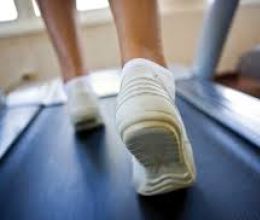Exercise Stress Test
The exercise stress test - also known as exercise electrocardiogram, treadmill test, or stress ECG - is a test used to provide information about how the heart responds to exertion (i.e. under stress).
The blood supply to the cardiac muscles (the myocardium) at rest, may be well met even in the presence of blocked arteries. However, when the heart is made to work harder, such as during exercise, the demand for blood to the myocardium increases. The blood flow through the blocked arteries may not be able to keep up with this increased demand. This is the principle behind the stress test.
When May You Need A Stress Test?
 Your doctor may recommend that you have stress test done in order to:
Your doctor may recommend that you have stress test done in order to:
• Determine if there is adequate blood flow to your heart during increased levels of activity.
• Determine if you have coronary heart disease (eg. as part of evaluating the cause of chest pain).
• Evaluate the effectiveness of medications to control angina.
• Check the effectiveness of procedures done to improve coronary artery blood flow eg. after balloon angioplasty or stenting.
• Identify abnormal heart rhythms, which may occasionally be brought on by exercise.
• Help you develop a safe exercise program.
How Should You Prepare for the Exercise Stress Test?
• Do not eat or drink anything except water for four hours before the test.
• Avoid drinking or eating caffeine-containing foods for at least 12 hours before the test. Caffeine may potentially interfere with the results of your test.
• You may need to avoid some of your regular heart medication on the day of the test. Do check with your doctor which medications you will need to avoid.
• If you use an inhaler for asthma or chronic obstructive pulmonary disease, bring it along for the test.
• Wear comfortable shoes and clothes for the test. You may want to put on your usual running gear.
What Should I Expect During The Treadmill Test?
Your chest area is cleaned, and if need be, shaved. Several electrodes will be placed on your chest, and a blood pressure monitor will be strapped on. After this, you are asked to walk on the treadmill. Most of the treadmill tests are done according to certain set protocols (eg the Bruce protocol). The speed and degree of inclination of the treadmill will increase by preset degrees at preset time intervals governed by the protocol. While you are walking on the treadmill, your heart rhythm is watched, blood pressure is measured and serial ECGs are recorded.
At regular intervals, the lab personnel will ask how you are feeling. Do let them know if you feel chest, arm, or jaw pain or discomfort, shortness of breath, dizziness, palpitations, or any other unusual symptoms. It is normal for your heart rate, blood pressure, and breathing rate to increase during the test. The lab personnel will watch for any symptoms or changes on the ECG monitor that suggest the test should be stopped.
You may also be asked to stop the test prematurely if:
• You are unable to continue walking (eg. you are too tired, your leg is painful etc).
• There are signs which indicate that continuing the test may be harmful eg. your blood pressure goes too high/low, you develop chest pain, significant rhythm or other ECG changes.
For a test to be useful, you should achieve at least 85% predicted heart rate. Predicted heart rate is calculated by a formula: 220 minus age. You should achieve at least 85% of this number.
After the test you will walk slowly for a couple of minutes to cool down. Your heart rate, blood pressure and ECG will continue to be monitored until they begin returning to normal.
Further Reading
The article above is meant to provide general information and does not replace a doctor's consultation.
Please see your doctor for professional advice.
